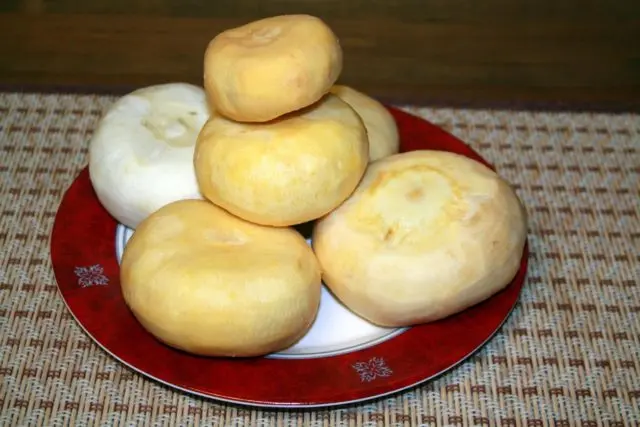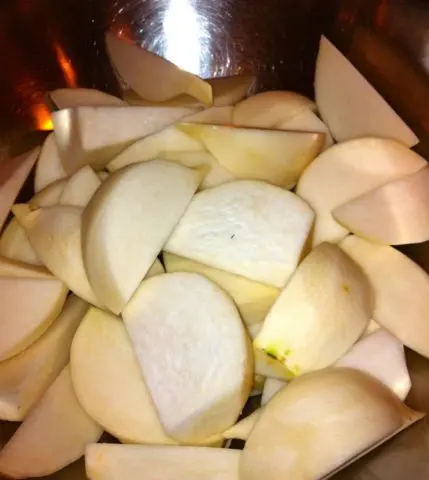Contents
- What is useful pickled turnip
- How to cook pickled turnips for the winter
- How to ferment turnips with apples
- Recipe for sauerkraut turnips with cabbage
- How to ferment turnips with carrots
- Recipe for pickled turnips with beets
- Express preparation of pickled turnips
- Turnip pickled with pepper for spicy lovers
- Possible failures and ways to eliminate them
- How to store pickled turnips
- What can be cooked from pickled turnips
- Conclusion
One of the directions of modern cooking is the revival of traditional recipes. A century ago, pickled turnips were a mandatory attribute of most dinners. Currently, this dish is regaining popularity and gaining more and more fans.

What is useful pickled turnip
Pickled turnip cooked according to the right recipe retains all its nutritional properties for the winter, which makes it extremely useful during a period of vitamin deficiency. The root crop is a source of a large amount of vitamins B1, B2, C, E and PP. In addition, the finished dish contains a huge amount of fiber necessary for the body.
In addition to vitamins, turnip contains elements such as beta-carotene and succinic acid. The vegetable is also rich in calcium, sulfur, phosphorus and iron. In smaller quantities, the most useful potassium, iodine and manganese are found.
One of the most important components of the root crop is glucoraphanin. This substance is characterized by a powerful antitumor effect that helps to curb the development of cancer. In people who consume glucoraphanin in sufficient quantities, the likelihood of developing diabetes mellitus tends to zero.
How to cook pickled turnips for the winter
The basis of the dish is turnip. It is her right choice that will allow you to get a delicious finished product. The best option for pickling are young root crops of medium and small size. The skin should be smooth, even and free of signs of mechanical damage.
Another important component in preparing for cooking is the right choice of dishes. It is worth abandoning the use of metal pots and basins, since the acid released during fermentation enters into a chemical reaction with the iron surface. Housewives advise centuries-old wooden utensils. In extreme cases, you can use glass jars.
What can you sour
There are a huge number of recipes for making pickled turnips. Each housewife keeps her own unique method, which allows her to get a delicious finished product.

Adding additional ingredients to pickled turnips allows you to better reveal the taste of the dish, as well as achieve additional flavor notes. Some people prefer the classic recipe, others lean towards more interesting options – with cabbage, apples or carrots. There are also completely non-traditional methods of preparation – among them, recipes that include a large number of hot spices are considered the most prominent.
How to ferment turnips with apples
The apple adds extra sourness to the finished dish. Depending on the variety, you can get a sweeter bouquet of taste. To prepare such a dish you need:
- 4 turnips;
- 4 apple;
- 70 grams of sugar;
- 70 g table salt;
- 20 peas of black pepper;
- 10 peas of sweet pepper;
- 5 bay leaves.
Root crops are peeled and finely chopped. Salt and sugar are added to them, after which they are rubbed with their hands so that the vegetable starts juice. Peel the apple, remove the pits and cut into small pieces.
In a jar prepared in advance, they put, alternating layers, turnips and apples. For each layer, add a few peppercorns and one bay leaf. The jar is covered with gauze and sent for 7-9 days to a warm place. Periodically, vegetables must be pierced with a wooden stick, allowing them to get rid of excess gases.
Recipe for sauerkraut turnips with cabbage
Cabbage is a great addition to sauerkraut. It contains substances necessary to speed up the cooking process. Such a pickled turnip recipe is considered traditional – monastic. For 1 head of cabbage, they usually take 2 medium root crops, 1 liter of water and 1 tbsp. l. salt. You can use your favorite spices if you like, but cumin works best.
First you need to prepare a salty brine. Water is put on fire and brought to a boil, salt and cumin are added to it. After that, it must be removed from the stove, strain from spices and cool to room temperature.
Vegetables are finely chopped and mixed, then tamped into a large jar, and then poured with prepared brine. The jar is placed in a cool place for 5 days. Vegetables must be stirred periodically so that they are completely covered with brine.
How to ferment turnips with carrots
Pickled turnip with carrots is a classic of cuisine. The combination of vegetables allows you to get a balanced taste and unsurpassed aroma. For cooking you will need:
- 1,5 kg carrots;
- 1,5 kg of turnip;
- 5 L of water;
- salt;
- 2 heads of garlic.
Root crops are not cleaned – they are washed under running water and dirt particles are removed with a stiff brush. Each vegetable is divided into 4 parts. Peel the garlic and cut each clove in half. All ingredients are transferred to a large container.

The water is brought to a boil. Salt is added to it to taste – the brine should not be too salty, since in the future acid from vegetables will be added to the salty taste. The water is cooled to room temperature, after which it is poured over vegetables. Turnips and carrots are pressed with oppression and sent for 3 weeks to a cool place.
Recipe for pickled turnips with beets
Using beets in the recipe allows you to add a sweet touch to the dish. In addition, beetroot allows you to get a more saturated color of the finished product. For cooking you will need:
- 1 kg of turnip;
- 200 g of beets;
- 100 g of garlic;
- 5 peas of sweet pepper;
- 2 laurel leaves;
- 1 L of water;
- 50 g salt.
Remove the peel from the root crops and rub them on a coarse grater. The garlic cloves are cut into quarters. Salt is diluted in a liter of boiled cooled water.
Chopped vegetables are placed in a prepared container. Spices are added to them and poured with salted brine. It is advisable to put turnips with beets under oppression so that the fermentation process proceeds faster. After a week of cooking, the finished vegetables are transferred to the banks and sent for further storage.
Express preparation of pickled turnips
To speed up the cooking process as much as possible, some subtleties are used. An important component is the fermentation process in a closed jar – this allows microorganisms not to volatilize and direct their vital activity directly to the processing of vegetables.
Turnips are cleaned, rubbed on a coarse grater and put in a small liter jar. For 500 g of root crops, you will need a brine of 400 ml of water and 1 tbsp. l. table salt. The jar is tightly closed with a nylon lid and sent for 3 days to a warm place.
Turnip pickled with pepper for spicy lovers
Spicy lovers can cook pickled turnips with hot spices. In this case, you can use both ground red pepper, and fresh chili and jalapeno. For cooking you will need:
- 1 kg of turnip;
- 300 g carrots;
- 2 chili peppers
- 2 L of water;
- 100 g table salt.
Vegetables are peeled and rubbed on a fine grater. Chili peppers are cut lengthwise, the seeds are removed from it and finely chopped. All ingredients are mixed and laid out in a container prepared for pickling.
Salt is diluted in cooled boiled water. The resulting brine is poured over vegetables. After that, the turnip container is placed in a cool place for 1-2 weeks. To increase the spiciness of the finished dish, you can add more pepper.

Possible failures and ways to eliminate them
The biggest problem that the hostess may face when preparing pickled turnips is the mustiness of the finished dish. Most often, this situation occurs when a large amount of waste products of microorganisms accumulate. To avoid such a problem, it is necessary to remove accumulated gases once a day. To do this, you need to shake the container with vegetables, and also slightly push the pieces of turnip apart with a wooden stick.
Another problem can be excessive addition of salt or spices. It is believed that the decision comes by experience. After several cooking cycles, each housewife will know the exact amount of additives needed to get the perfect taste.
How to store pickled turnips
If the product is stored for future use, care should be taken to preserve it during the winter months. After stopping the fermentation processes, the finished vegetables are transferred to small glass jars and sealed tightly to avoid possible air ingress. Under properly observed storage conditions, pickled turnips can be stored for up to 6 months.
The ideal temperature for storage is 0-2 degrees. A refrigerator with the ability to set temperature conditions is best suited. Also a great place for storage is a cold unheated cellar. The place should be as dark as possible, since direct sunlight has a detrimental effect on the consumer qualities of most types of conservation.
What can be cooked from pickled turnips
As with sauerkraut, turnips are a great addition to a variety of soups. Rassolnik and borsch will get an interesting sourness, which gourmets will appreciate. Shchi with pickled turnips is an example of traditional cuisine that has been passed down from generation to generation.
An excellent option for using the finished dish is to add it to pies. As a single filling, or in combination with other ingredients, turnips can turn an ordinary recipe into a work of culinary art.
Another way to bring out the taste of pickled turnips is to add them to various salads. It is believed that this vegetable goes well with potatoes and lean meats – chicken and beef. The sour-salty taste of the root crop allows you to better reveal and balance all the ingredients of the salad.
Conclusion
Pickled turnip is a traditional recipe that has been tested for centuries. Adding various ingredients to the recipe allows you to get interesting and unique tastes. Under proper storage conditions, this delicacy will delight with vitamins throughout the winter.









